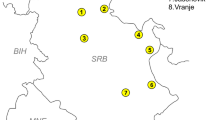Abstract
The planthopper Prokelisia marginata VanDuzee (Homoptera: Delphacidae) has beenconsidered for the biological control of theweed Spartina alterniflora Loisel(Poaceae) in Willapa Bay, Washington, U.S.A. Prokelisia marginata is a stenophagousphloem-feeding insect with the potential totransmit bacterial plant diseases that could bemoved by less-specific vectors to other plantspecies. Initial assays with PCR primers thatare putatively specific for phytoplasmas gavepositive results in Spartina. However,subsequent analyses did not indicate thetransmission of the pathogen by theplanthopper. We sequenced the 16S ribosomalRNA (rRNA) gene of the bacterial species thatgave positive results in PCR. Comparisons withsequences available in GenBank suggested thatthe positive results using the putativelyspecific PCR primers were due to the presenceof such bacteria as Pseudomonas, Holomonas, Vibrio, and Acinetobacter. We did not find phytoplasmasin either Spartina or the planthopperP. marginata.
Similar content being viewed by others
References
Altschul, S.F., T.L. Madden, A.A. Schaffer, J. Zhang, Z. Zhang, W. Miller and D.J. Lipman, 1997. Gapped BLAST and PSI-BLAST: a new generation of protein database search programs. Nucleic Acids Res. 25: 3389–3402.
Bezark, L.G., 1999. Report for Secretary Lyons from the California Department of Food and Agriculture Glassy-Winged Sharpshooter/Pierce's Disease Task Force. Report of the University of California Pierce's Disease Research and Emergency Response Task Force.
Daehler, C.C. and D.R. Strong, 1997. Reduced herbivore resistance in introduced smooth cordgrass (Spartina alterniflora) after a century of herbivore-free growth. Oecologia 110: 99–108.
Deng, S. and D. Hiruki, 1991. Amplification of 16S rRNA genes from culturable and nonculturable mollicutes. J. Microbiol. Methods 114: 53–61.
Denno, R.F., M.E. Schauff, S.W. Wilson and K.L. Olmstead, 1987. Practical diagnosis and natural history of two sibling salt marsh-inhabiting planthoppers in the genus Prokelisia (Homoptera; Delphacidae). Proceedings of the Entomological Society of Washington 89: 687–700.
Eastop, V.F., 1977. Worldwide importance of aphids as virus vectors. In: K.F. Harris and K. Maramorosch (eds), Aphids as Virus Vectors. Academic Press, New York, NY. pp. 3–62.
Grevstad, F., M. Wecker, D. Strong, A. Hastings, J. Civille, D. Garcia-Rossi, H. Davis and K. Sayce, 2000. A petition to import Prokelisia marginata to Willapa Bay, Washington from California for the biological control of Spartina alterniflora. Submitted to the Technical Advisory Group (TAG) for the Animal and Plant Health Inspection Service (APHIS) of the United States Department of Agriculture (USDA).
Kuske, C.R., and B.C. Kirkpatrick, 1992. Distribution and multiplication of Western Aster Yellows Mycoplasmalike organisms in Catharanthus roseus as determined by DNA Hybridization Analysis. Phytopathology 82: 457–462.
Lee, I.M., D.E. Gundersen-Rindal and A. Bertaccini, 1998. Phytoplasma: Ecology and genomic diversity. Phytopathology 88: 1359–1366.
Pemberton, R.W. and D.R. Strong, 2000. Safety data crucial for biological control insect agents. Science 290: 1896–1897.
Purcell, A.H. 1982. Insect vector relationships with prokaryotic plant pathogens. Annual Review of Phytopathology 20: 397–417.
Radford, A.E., H.E. Ahles and C.R. Bell, 1968. Manual of the vascular flora of the Carolinas. University of North Carolina Press, Chapel Hill, NC.
SAS 7.0. 1998. SAS Institute Inc. Cary, NC.
Schneider, B., E. Seemuller, C.D. Smart and B.C. Kirkpatrick, 1995. Phylogenetic classi-fication of plant pathogenic mycoplasma-like organisms or phytoplasmas, In: S. Razin and J.G. Tully (eds), Molecular and Diagnostic Procedures in Mycoplasmology, Vol.I. Academic Press, San Diego, CA. pp. 369–380.
Seemueller, E. and B.C. Kirkpatrick, 1996. Detection of phytoplasma infections in plants. In: J.G. Tully and S. Razin (eds), Molecular and Diagnostic Procedures in Mycoplasmology, Vol. II. Academic Press, San Diego, CA. pp. 291–311.
Smart, C.D., B. Schneider, C.L. Blomquist, L.J. Guerra, N.A. Harrison, U. Ahrens, K.H. Lorenz, E. Seemueller and B.C. Kirkpatrick, 1996. Phytoplasma-specific PCR primers based on sequences of the 16S-23S rRNA spacer region. Applied and Environmental Microbiology 62: 2988–2993.
Strong, D.R. and R.W. Pemberton, 2000. Biological control of invading species: risk and reform. Science 288: 1969–1970.
Thomas, M.B. and A.J. Willis, 1998. Biocontrol-risky but necessary? TREE 13: 325–329.
Zhang, Y.P., J.K. Uyemoto and B.C. Kirkpatrick, 1998. A small-scale procedure for extracting nucleic acids from woody plants infected with various phytopathogens for PCR assay. Journal of Virological Methods 71: 45–50.
Author information
Authors and Affiliations
Corresponding author
Rights and permissions
About this article
Cite this article
Davis, H.G., Garcia-Rossi, D., Daoust, M. et al. The use of molecular assays to identify plant pathogenic organisms vectored by biological control agents. BioControl 47, 487–497 (2002). https://doi.org/10.1023/A:1016585728169
Issue Date:
DOI: https://doi.org/10.1023/A:1016585728169




